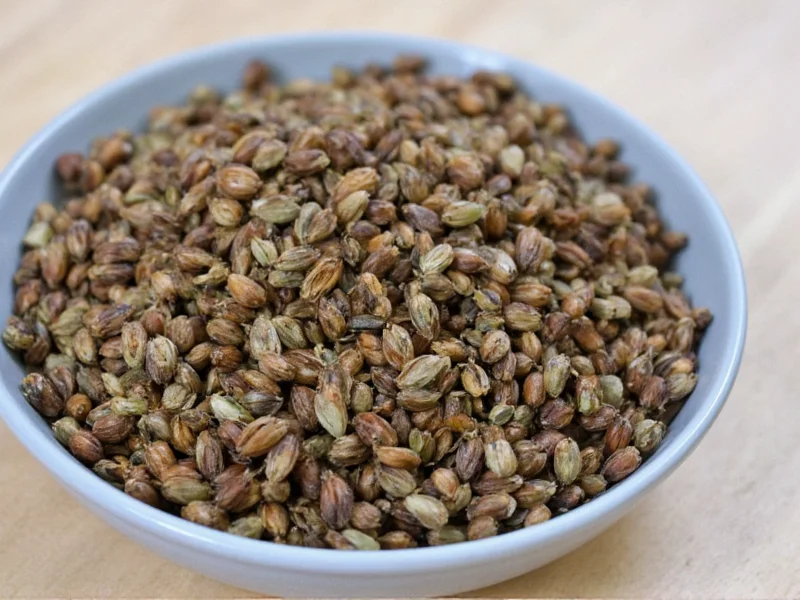Understanding Dry Juniper Berries
Dry juniper berries represent the fully ripened and dehydrated form of juniper galbuli (seed cones). Despite their name, juniper "berries" aren't true berries but modified cones that take 18-24 months to mature. The drying process intensifies their complex flavor profile while extending shelf life significantly compared to fresh counterparts.
Harvested when deep blue-purple and fully ripe, juniper berries undergo careful sun-drying or low-temperature dehydration. This process reduces moisture content from approximately 80% in fresh berries to under 10% in dried form. The transformation concentrates essential oils containing terpenes like pinene and myrcene, creating the distinctive aromatic profile valued by chefs and distillers worldwide.
Culinary Applications of Dried Juniper Berries
Chefs prize dried juniper berries for their robust flavor that withstands long cooking times. When cooking with dried juniper berries, proper preparation maximizes their potential:
- Crushing technique: Lightly crush berries just before use to release essential oils
- Meat pairings: Complement game meats like venison, wild boar, and duck exceptionally well
- Marinade ratios: Use 5-8 crushed berries per pound of meat for balanced flavor
- Stock enhancement: Add 3-4 berries to game meat stocks for depth
The juniper berry flavor profile features pine notes reminiscent of rosemary, citrus undertones, and subtle peppery heat. Unlike fresh berries, dried versions deliver more consistent flavor in recipes due to stabilized essential oil content. For dried juniper berries vs fresh comparisons, dried variants offer longer shelf life and more concentrated flavor, while fresh berries provide brighter citrus notes but spoil within weeks.
Storage Guidelines for Maximum Freshness
Proper storage determines how long your dried juniper berries maintain peak quality. Follow these evidence-based storage tips for dried juniper berries:
| Storage Method | Shelf Life | Quality Preservation |
|---|---|---|
| Airtight container at room temperature | 12-18 months | Good |
| Refrigerated in glass container | 18-24 months | Excellent |
| Freezer in vacuum-sealed bag | 24-36 months | Superior |
Exposure to light, heat, and humidity rapidly degrades volatile compounds. Store away from stoves, windows, and other heat sources. Check periodically for mold or musty odors indicating spoilage. Properly stored dried juniper berries maintain deep blue-purple color and strong aromatic scent.
Nutritional Composition and Research Insights
While primarily used for flavor, dried juniper berries contain bioactive compounds worthy of consideration. Per 100g, they provide:
- Approximately 270 calories
- 12g dietary fiber
- Significant manganese and vitamin C
- Terpenes including alpha-pinene and limonene
Current research on health benefits of dried juniper berries shows promising but preliminary results. Studies suggest potential diuretic properties and antioxidant effects, though most evidence comes from animal models or in vitro studies. Traditional European medicine has used juniper for digestive support, but modern applications require professional guidance due to potential interactions with medications.
Safety Considerations and Responsible Usage
Understanding proper usage prevents adverse effects. Key safety points include:
- Limited to culinary amounts (typically 1-2g per serving)
- Avoid during pregnancy due to potential uterine stimulation
- Contraindicated with kidney disease or kidney-related medications
- Discontinue use if experiencing abdominal pain or kidney discomfort
The European Medicines Agency recommends maximum daily intake of 10g of dried berries for adults. When exploring how to use dried juniper berries in cooking, remember that moderation preserves both flavor balance and safety. Those with autoimmune conditions or taking prescription medications should consult healthcare providers before regular consumption.
Practical Applications in Modern Cuisine
Chefs worldwide incorporate dried juniper berries beyond traditional European dishes. Contemporary applications include:
- Infused vinegars: Steep 15 crushed berries in 500ml vinegar for 2 weeks
- Rub formulations: Combine with black pepper, coriander, and thyme
- Cocktail elements: Muddle in craft cocktails for botanical complexity
- Bread enhancements: Add to rye or sourdough doughs (2-3 berries per loaf)
For those seeking juniper berry substitutes, consider equal parts rosemary combined with black pepper and a pinch of allspice. However, no substitute perfectly replicates juniper's unique flavor profile essential to dishes like sauerbraten and traditional Scandinavian game preparations.
Can I substitute dried juniper berries for fresh in recipes?
Yes, dried juniper berries work as a 1:1 substitute for fresh in most cooked dishes. Use slightly fewer dried berries (about 20% less) in raw applications since drying concentrates their flavor. Always crush dried berries before use to maximize flavor release.
How can I tell if my dried juniper berries have gone bad?
Spoiled dried juniper berries lose their characteristic pine aroma, appearing dull gray instead of deep blue-purple. They may develop mold, musty odors, or become brittle and crumble easily. Properly stored berries maintain strong fragrance for 12-24 months.
Are dried juniper berries safe for regular consumption?
In culinary amounts (typically 1-2g per serving), dried juniper berries are safe for most adults. Avoid regular consumption exceeding 10g daily or prolonged use beyond 4 weeks without professional guidance. Those with kidney conditions, pregnant women, and individuals on medication should consult healthcare providers first.
What's the best way to crush dried juniper berries?
Use a mortar and pestle for optimal control, applying moderate pressure to crack rather than pulverize. Alternatively, place berries in a sealed bag and gently crush with a rolling pin. Avoid spice grinders which can over-process and generate heat that degrades volatile compounds.
Where can I find high-quality dried juniper berries?
Look for dried juniper berries at specialty spice shops, well-stocked grocery stores with robust spice sections, or reputable online retailers. Quality indicators include deep blue-purple color, strong pine-citrus aroma, and absence of stems or debris. European-sourced berries often provide more consistent flavor profiles for traditional recipes.











 浙公网安备
33010002000092号
浙公网安备
33010002000092号 浙B2-20120091-4
浙B2-20120091-4